 W
WAesop's Fables is a 2000 collection of 61 fables from the Aesop oeuvre, retold by Jerry Pinkney. It includes stories about wolves, foxes, lions, dogs, mice, and donkeys.
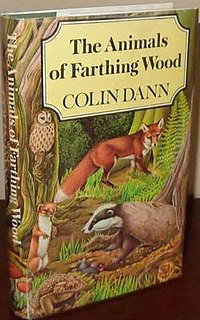 W
WThe Animals of Farthing Wood is the first book of the Animals of Farthing Wood book series, which was later adapted into a TV series of the same name. It was first published in 1979. An abridged version of 70 pages, by the same author, was published in 1993 to accompany the TV series.
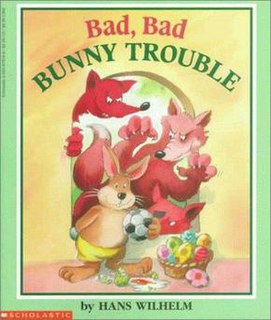 W
WBad, Bad Bunny Trouble is a 1994 children's picture book written and illustrated by Hans Wilhelm. It is the second book of the Bunny Trouble trilogy, a series about Ralph, a soccer-loving rabbit who frequently causes trouble with his family and friends. It is preceded by Bunny Trouble and followed by More Bunny Trouble.
 W
WIn the children's picture book Chanticleer and the Fox, Barbara Cooney adapted and illustrated the story of Chanticleer and the Fox as told in The Nun's Priest's Tale in Chaucer's Canterbury Tales, translated by Robert Mayer Lumiansky. Published by Crowell in 1958, it was the recipient of the Caldecott Medal for illustration in 1959. It was also one of the Horn Book "best books of the year".
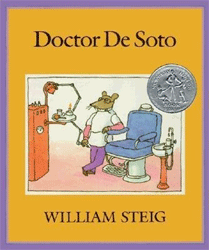 W
WDoctor De Soto is a picture book for children written and illustrated by William Steig and first published in 1982. It features a mouse dentist who must help a fox with a toothache without being eaten.
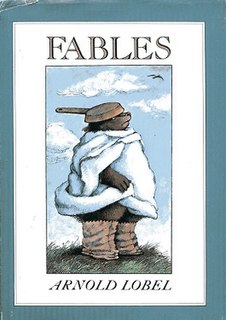 W
WFables is a children's picture book by American author Arnold Lobel. Released by Harper & Row in 1980, it was the recipient of the Caldecott Medal for illustration in 1981.
 W
WFantastic Mr Fox is a children's novel written by British author Roald Dahl. It was published in 1970, by George Allen & Unwin in the UK and Alfred A. Knopf in the U.S., with illustrations by Donald Chaffin. The first U.K. Puffin paperback, first issued in 1974, featured illustrations by Jill Bennett. Later editions have featured illustrations by Tony Ross (1988) and Quentin Blake (1996). The story is about Mr Fox and how he outwits his farmer neighbours to steal their food from right under their noses. In 2009, it was adapted into a stop-motion animated film by Wes Anderson.
 W
WFinding the Fox is a fantasy/science fiction novel by Ali Sparkes. It is the first book in The Shapeshifter series, and was first published in 2006 by Oxford University Press.
 W
WFlossie & the Fox is a 1986 picture book by Patricia C. McKissack about a girl, Flossie, who takes some eggs to a neighbor, meets a fox on the way and manages to outwit it. In 1991, a film adaptation of the book was made with the author narrating.
 W
WThe Fox and the Hound is a 1967 novel written by American novelist Daniel P. Mannix and illustrated by John Schoenherr. It follows the lives of Tod, a red fox raised by a human for the first year of his life, and Copper, a half-bloodhound dog owned by a local hunter, referred to as the Master. After Tod causes the death of the man's favorite hound, man and dog relentlessly hunt the fox, against the dual backdrops of a changing human world and Tod's normal life in hunting for food, seeking a mate, and defending his territory. As preparation for writing the novel, Mannix studied foxes, both tame and wild, a wide variety of hunting techniques, and the ways hounds appear to track foxes, seeking to ensure his characters acted realistically.
 W
WThe Fox and the Star is an illustrated book by Coralie Bickford-Smith, a cover designer at Penguin Books. Published in 2015, it was chosen as that year's Waterstones Book of the Year, beating highly acclaimed contenders including Harper Lee’s Go Set a Watchman, Elena Ferrante’s My Brilliant Friend, Paula Hawkins’ The Girl on the Train, and A Little Life by Hanya Yanagihara.
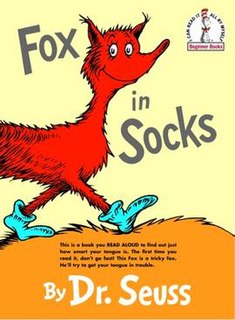 W
WFox in Socks is a children's book by Dr. Seuss, first published in 1965. It features two main characters, Fox who speaks almost entirely in densely rhyming tongue-twisters and Knox who has a hard time following up Fox's tongue-twisters until the end.
 W
WFox Tales is a 1976 anthology of 16 animal-centered fairy tales from around the world that have been collected and retold by Ruth Manning-Sanders. These tales are written for a slightly younger level of reader than Manning-Sanders' more familiar "A Book of..." series of fairy tales.
 W
WGon, the Little Fox is a Japanese children's story about the life of a little fox called Gon. The story is considered the masterpiece of Niimi Nankichi, also sometimes known as the Hans Christian Andersen of Japan.
 W
WThe Gruffalo is a British children's picture book by writer and playwright Julia Donaldson, illustrated by Axel Scheffler, that tells the story of a mouse, the protagonist of the book, taking a walk in the woods. The book has sold over 13 million copies, has won several prizes for children's literature, and has been developed into plays on both the West End and Broadway and even an Oscar nominated animated film.
 W
WThe Gruffalo's Child is a British children's picture book by writer and playwright Julia Donaldson, and illustrated by Axel Scheffler. It is the bestselling sequel to The Gruffalo.
 W
WThe Hedgehog and the Fox is an essay by philosopher Isaiah Berlin—one of his most popular essays with the general public—which was published as a book in 1953. However, Berlin said, "I meant it as a kind of enjoyable intellectual game, but it was taken seriously. Every classification throws light on something". Indeed, it has been compared to "an intellectual’s cocktail-party game".
 W
WLady into Fox was David Garnett's first novel using his own name, published in 1922. This short and enigmatic work won the James Tait Black Memorial Prize, and the Hawthornden Prize a year later. Being a work of fantasy set in the present-day society, it fits into the category of Contemporary Fantasy which was not yet recognized as a distinct genre at the time of writing.
 W
WLittle Foxes is a book written by Michael Morpurgo in 1984
 W
WMarlfox is a fantasy novel by Brian Jacques, published in 1998. It is the 11th book published and 13th chronologically in the Redwall series. Marlfoxes are an unusual breed of anthropomorphic foxes, which serve as the main antagonists in the book.
 W
WMartin's Mice is a children's book about a cat who befriends mice. It was written by Dick King-Smith. The first edition was published in 1988 by Gollancz Books.
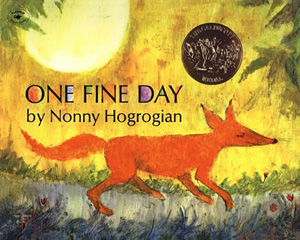 W
WOne Fine Day is a children's picture book by Nonny Hogrogian. Released by Macmillan, it was the recipient of the Caldecott Medal for illustration in 1972. The story is a retelling of an Armenian folktale.
 W
WThe Plague Dogs is the third novel by Richard Adams, author of Watership Down, about the friendship of two dogs that escape an animal testing facility and are subsequently pursued by both the government and the media. It was first published in 1977, and features a few location maps drawn by Alfred Wainwright, a fellwalker and author. The conclusion of the book involves two real-life characters, Adams' long-time friend Ronald Lockley, and the world-famous naturalist Sir Peter Scott. Having seen a manuscript, both men readily agreed to be identified with the characters and opinions that Adams had attributed to them, as is shown in Adams' preface to the book.
 W
WRinkin of Dragon's Wood is a children's book by Thora Colson published in Britain in 1965. It was Colson's first novel and was illustrated by Pat Marriott. It was also published in the United States by Dutton, and the German translation was published in Austria by Ueberreuter.
 W
WSora Iro no Tane is a 1964 Japanese children's picture book by Rieko Nakagawa and illustrated by Yuriko Ōmura. It was serialized by Fukuin Kanshoten in their Kodomo no Tomo (こどものとも) magazine in 1964, and then published as a book in 1967. Since being published in the magazine, it has been in continuous publication and had sold over a 1.7 million copies in Japan by 2010.
 W
WThe Tale of Jemima Puddle-Duck is a children's book written and illustrated by Beatrix Potter. It was first published by Frederick Warne & Co. in July 1908. Potter composed the book at Hill Top, a working farm in the Lake District she bought in 1905. Following the purchase, her works began to focus on country and village life, incorporating large casts of animal characters and sinister villains. Jemima Puddle-Duck was the first of her books set wholly at the farm with background illustrations based on the farm buildings and yard, and nearby locales.
 W
WThe Tale of Mr. Tod is a children's book written and illustrated by Beatrix Potter, first published by Frederick Warne & Co. in 1912. The tale is about a badger called Tommy Brock and his arch enemy Mr. Tod, a fox. Brock kidnaps the children of Benjamin Bunny and his wife Flopsy, intending to eat them, and hides them in an oven in the home of Mr. Tod. Benjamin and his cousin Peter Rabbit have followed Tommy Brock in an attempt to rescue the babies. When Mr. Tod finds Brock asleep in his bed, he determines to get him out of the house. His initial attempt fails, and the two eventually come to blows. Under cover of the fight, the rabbits rescue the baby rabbits. The tale was influenced by the Uncle Remus stories, and was set in the fields of Potter's Castle Farm. Black and white illustrations outnumber those in colour. The tale is critically considered one of Potter's "most complex and successful in plot and tone."
 W
WThat Is NOT a Good Idea! is a 2013 book by Mo Willems about a plump fowl that meets a fox, and is persuaded to follow the fox to its house in the woods, all the while being observed, as if on a movie screen, by a group of young birds that regularly shout the title words.
 W
WViolette's Daring Adventure is the sixth book in the Beechwood Bunny Tales series. It was originally published by France's Éditions Milan in 1991, and in the United States by Gareth Stevens a year later. The book was awarded the Soleils d'Or at 1991's BD Festival.
 W
WVuk is a 1965 Hungarian children's novel by István Fekete about the life of a young fox.